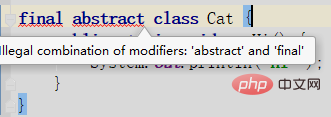
What is the difference between JDK and JRE?
JDK: The abbreviation of Java Development Kit, java development tool kit, provides java development environment and running environment.
JRE: The abbreviation of Java Runtime Environment, java runtime environment, provides the required environment for the operation of java. (Recommended study: java common interview questions)
Specifically, JDK actually includes JRE, and also includes the compiler javac that compiles java source code, and also includes many java program debugging and Tools for analysis. To put it simply: if you need to run java programs, you only need to install JRE. If you need to write java programs, you need to install JDK.
== What is the difference between equals and equals?
The effects of == are different for basic types and reference types, as follows:
Basic types: What is compared is whether the values are the same;
Reference type: What is compared is whether the references are the same;
quals is essentially ==, except that String and Integer override the equals method and turn it into a value comparison.
== For basic types, it is a value comparison, for reference types, it is a reference comparison; and equals is a reference comparison by default, but many classes override the equals method, such as String, Integer etc. turns it into a value comparison, so under normal circumstances equals compares whether the values are equal.
If the hashCode() of two objects is the same, equals() must also be true, right?
No, the hashCode() of the two objects is the same, and equals() may not be true.
String str1 = "通话";
String str2 = "重地";
System.out.println(String.format("str1:%d | str2:%d", str1.hashCode(),str2.hashCode()));
System.out.println(str1.equals(str2));Result of execution:
str1:1179395 | str2:1179395 false
Code interpretation: Obviously the hashCode() of "call" and "powerful place" are the same, but equals() is false, Because in a hash table, equal hashCode() means that the hash values of two key-value pairs are equal. However, equal hash values do not necessarily mean that the key-value pairs are equal.
What is the role of final in java?
The final modified class is called the final class, and this class cannot be inherited.
Final modified methods cannot be overridden.
Final modified variables are called constants. Constants must be initialized. After initialization, the value cannot be modified.
What is Math.round(-1.5) in java equal to?
is equal to -1.
String is a basic data type?
String does not belong to the basic type. There are 8 basic types: byte, boolean, char, short, int, float, long, double, and String belongs to the object.
What are the classes for operating strings in java? What's the difference between them?
The classes that operate on strings include: String, StringBuffer, and StringBuilder.
The difference between String and StringBuffer and StringBuilder is that String declares an immutable object. Each operation will generate a new String object, and then point the pointer to the new String object, while StringBuffer and StringBuilder can be used in the original object. The operation is performed on the basis of , so it is best not to use String when the content of the string is frequently changed.
The biggest difference between StringBuffer and StringBuilder is that StringBuffer is thread-safe, while StringBuilder is non-thread-safe, but the performance of StringBuilder is higher than StringBuffer, so it is recommended to use StringBuilder in a single-threaded environment and in a multi-threaded environment. It is recommended to use StringBuffer.
String str="i" is the same as String str=new String("i")?
It’s different because the memory allocation method is different. String str="i", the Java virtual machine will allocate it to the constant pool; and String str=new String("i") will be allocated to the heap memory.
How to reverse a string?
Use the reverse() method of StringBuilder or stringBuffer.
Sample code:
// StringBuffer reverse
StringBuffer stringBuffer = new StringBuffer();
stringBuffer.append("abcdefg");
System.out.println(stringBuffer.reverse()); // gfedcba
// StringBuilder reverse
StringBuilder stringBuilder = new StringBuilder();
stringBuilder.append("abcdefg");
System.out.println(stringBuilder.reverse()); // gfedcbaWhat are the common methods of the String class?
indexOf():返回指定字符的索引。 charAt():返回指定索引处的字符。 replace():字符串替换。 trim():去除字符串两端空白。 split():分割字符串,返回一个分割后的字符串数组。 getBytes():返回字符串的 byte 类型数组。 length():返回字符串长度。 toLowerCase():将字符串转成小写字母。 toUpperCase():将字符串转成大写字符。 substring():截取字符串。 equals():字符串比较。
Do abstract classes have to have abstract methods?
No, abstract classes do not necessarily have to have abstract methods.
Sample code:
abstract class Cat {
public static void sayHi() {
System.out.println("hi~");
}
}In the above code, the abstract class does not have abstract methods but it can run normally.
What are the differences between ordinary classes and abstract classes?
Ordinary classes cannot contain abstract methods, while abstract classes can contain abstract methods.
Abstract classes cannot be instantiated directly, but ordinary classes can be instantiated directly.
Can abstract classes be modified with final?
No, defining an abstract class is for other classes to inherit. If it is defined as final, the class cannot be inherited, which will cause conflicts with each other, so final cannot modify the abstract class, as shown in the figure below , the editor will also prompt an error message:

What is the difference between an interface and an abstract class?
Implementation: Subclasses of abstract classes use extends to inherit; interfaces must use implements to implement the interface.
构造函数:抽象类可以有构造函数;接口不能有。
main 方法:抽象类可以有 main 方法,并且我们能运行它;接口不能有 main 方法。
实现数量:类可以实现很多个接口;但是只能继承一个抽象类。
访问修饰符:接口中的方法默认使用 public 修饰;抽象类中的方法可以是任意访问修饰符。
java 中 IO 流分为几种?
按功能来分:输入流(input)、输出流(output)。
按类型来分:字节流和字符流。
字节流和字符流的区别是:字节流按 8 位传输以字节为单位输入输出数据,字符流按 16 位传输以字符为单位输入输出数据。
BIO、NIO、AIO 有什么区别?
BIO:Block IO 同步阻塞式 IO,就是我们平常使用的传统 IO,它的特点是模式简单使用方便,并发处理能力低。
NIO:New IO 同步非阻塞 IO,是传统 IO 的升级,客户端和服务器端通过 Channel(通道)通讯,实现了多路复用。
AIO:Asynchronous IO 是 NIO 的升级,也叫 NIO2,实现了异步非堵塞 IO ,异步 IO 的操作基于事件和回调机制。
Files的常用方法都有哪些?
Files.exists():检测文件路径是否存在。 Files.createFile():创建文件。 Files.createDirectory():创建文件夹。 Files.delete():删除一个文件或目录。 Files.copy():复制文件。 Files.move():移动文件。 Files.size():查看文件个数。 Files.read():读取文件。 Files.write():写入文件。
The above is the detailed content of Common basic Java interview questions. For more information, please follow other related articles on the PHP Chinese website!